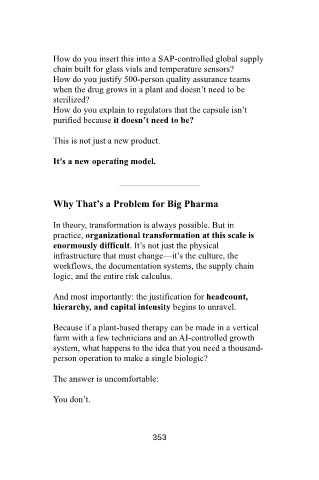Page 355 - Binder2
P. 355
How do you insert this into a SAP-controlled global supply
chain built for glass vials and temperature sensors?
How do you justify 500-person quality assurance teams
when the drug grows in a plant and doesn’t need to be
sterilized?
How do you explain to regulators that the capsule isn’t
purified because it doesn’t need to be?
This is not just a new product.
It’s a new operating model.
Why That’s a Problem for Big Pharma
In theory, transformation is always possible. But in
practice, organizational transformation at this scale is
enormously difficult. It’s not just the physical
infrastructure that must change—it’s the culture, the
workflows, the documentation systems, the supply chain
logic, and the entire risk calculus.
And most importantly: the justification for headcount,
hierarchy, and capital intensity begins to unravel.
Because if a plant-based therapy can be made in a vertical
farm with a few technicians and an AI-controlled growth
system, what happens to the idea that you need a thousand-
person operation to make a single biologic?
The answer is uncomfortable:
You don’t.
353

